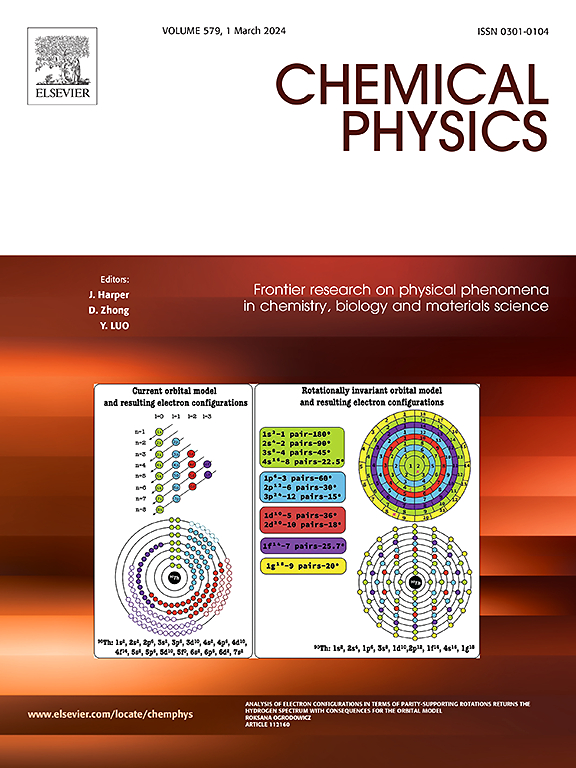质子化腺苷及其与氨基酸对映体的氢键团簇的紫外光解光谱
IF 2.4
3区 化学
Q4 CHEMISTRY, PHYSICAL
引用次数: 0
摘要
采用紫外光解光谱法,在8k气相下研究了氢键对核苷光化学性质的影响。光诱导的质子化腺苷键裂解被组氨酸氢键抑制。在质子化腺苷的光谱中,在288 nm处观察到明显的条带和较宽的条带。宽频带与d-组氨酸氢键的质子化腺苷相似。在与l-组氨酸氢键的质子化腺苷的光谱中,随着激发能的增加,相对强度逐渐增大,在285 nm处开始吸收。质子化的腺苷及其与d-组氨酸的氢键簇的质子化位点位于腺嘌呤部分的N3位置。质子化腺苷与l-组氨酸氢键的质子化位点为N1。与n1 -质子化的腺苷相比,n1 -质子化的腺苷的S1-S0跃迁发生了红移。腺苷通过质子化及其电子结构识别对映体。本文章由计算机程序翻译,如有差异,请以英文原文为准。

Ultraviolet photodissociation spectroscopy of protonated adenosine and its hydrogen-bonded clusters with amino acid enantiomers
The effects of hydrogen bonding on the photochemical properties of nucleosides were investigated using ultraviolet photodissociation spectroscopy at 8 K in the gas phase. Photoinduced glycosidic bond cleavage of protonated adenosine is inhibited by hydrogen bonding with histidine. In the spectrum of protonated adenosine, a distinct band at 288 nm and broad bands were observed. The broad bands were similar to those of protonated adenosine hydrogen-bonded to d-histidine. In the spectrum of protonated adenosine hydrogen-bonded with l-histidine, the relative intensity increased gradually with increasing excitation energy, with the absorption onset at 285 nm. The protonation sites of protonated adenosine and its hydrogen-bonded cluster with d-histidine were located at the N3 position of the adenine moiety. The protonation site of protonated adenosine hydrogen-bonded with l-histidine was N1. The S1–S0 transition of N3-protonated adenosine was red-shifted compared to that of N1-protonated adenosine. Adenosine recognizes enantiomers through protonation and its electronic structure.
求助全文
通过发布文献求助,成功后即可免费获取论文全文。
去求助
来源期刊

Chemical Physics
化学-物理:原子、分子和化学物理
CiteScore
4.60
自引率
4.30%
发文量
278
审稿时长
39 days
期刊介绍:
Chemical Physics publishes experimental and theoretical papers on all aspects of chemical physics. In this journal, experiments are related to theory, and in turn theoretical papers are related to present or future experiments. Subjects covered include: spectroscopy and molecular structure, interacting systems, relaxation phenomena, biological systems, materials, fundamental problems in molecular reactivity, molecular quantum theory and statistical mechanics. Computational chemistry studies of routine character are not appropriate for this journal.
 求助内容:
求助内容: 应助结果提醒方式:
应助结果提醒方式:


